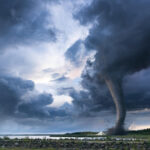Florida declared a state of emergency before a possible hurricane strike after Irma strengthened to become a Category 5 storm on its approach to the Caribbean.
Irma’s maximum winds rose as high as 175 miles an hour (280 kilometers an hour), the U.S. National Hurricane Center said in an advisory on Tuesday. The storm is located about 270 miles east of the Caribbean island of Antigua and headed toward the Leeward Islands.
“Irma becomes an extremely dangerous Category 5 hurricane,” the NHC said in the advisory. “Preparations should be rushed to completion in the hurricane warning area.”
The threat to the southeastern U.S. comes less than two weeks after Hurricane Harvey smashed ashore in Texas, causing widespread damage, power outages and flooding and taking almost a fifth of U.S. refining capacity offline.
“There is an increasing chance of seeing some impacts from Irma in the Florida Peninsula and the Florida Keys later this week,” the National Hurricane Center said in an earlier advisory on Tuesday, after Governor Rick Scott declared an emergency.
In Florida, the citrus crop will be a focus of concern as the state is the world’s largest producer of orange juice after Brazil. The oil and natural gas markets are also keeping a close eye on the storm, worrying whether it could reach the important U.S. Gulf of Mexico oil region.
“The expected path has shifted considerably west over the last two days and can still change over the next two,” said Olivier Jakob, founder of energy consultant Petromatrix GmbH in Zug, Switzerland. “We cannot yet rule out a move further west with a Louisiana risk.”
Beyond the threat to people and property in the Caribbean, the focus so far is on agriculture with the storm, “being a case of being long orange Juice futures rather than gasoline futures,” Jakob said.
Irma will probably cross the northern Leeward Islands Tuesday into Wednesday, according to the NHC, which said it’s still too early to determine what impact it might have on the U.S. Hurricane warnings have been issued for the U.S. and British Virgin Islands, Puerto Rico, Vieques, and Culebra. Tropical-storm-force winds could arrive in the British and U.S. Virgin Islands and Puerto Rico by early Wednesday.
About two-thirds of Florida’s citrus crop is located in the lower two-thirds of the peninsula. Frozen concentrated orange juice futures in New York already rose last week on speculation the storm could strike, though prices are down almost 30 percent since January.





















 How We’re Doing It: Boosting Corporate Culture and Customer Experience
How We’re Doing It: Boosting Corporate Culture and Customer Experience  Is State Farm General a Sinking Ship? California Emergency Rate Request Dropped to 17%
Is State Farm General a Sinking Ship? California Emergency Rate Request Dropped to 17%  2024 Second on Record for Most Tornadoes in the U.S. in a Year
2024 Second on Record for Most Tornadoes in the U.S. in a Year  AI Weather Models Promise Super Granular, Specialist Forecasts
AI Weather Models Promise Super Granular, Specialist Forecasts 






